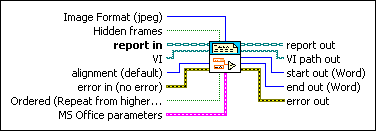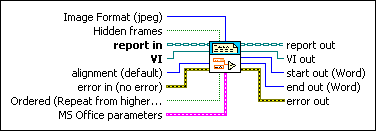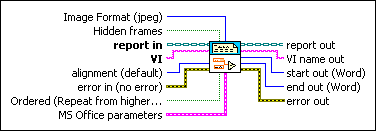 |
image format sets the format in which to save the image.
|
 |
If hidden frames is TRUE, the block diagram image includes all visible subdiagrams of each Case, Event, and Stacked Sequence structure, followed by all hidden subdiagrams for each structure. If FALSE (default), the image includes only visible subdiagrams.
|
 |
report in is a reference to the report whose appearance, data, and printing you want to control. Use the Create Report VI to generate this LabVIEW class object.
|
 |
VI is the path to the VI whose image you want to append to the report. The default is the path to the VI that contains this VI as a subVI.
|
 |
alignment sets the alignment of the image in a report. (Report Generation Toolkit) For Microsoft Word reports, you can use only the LEFT, RIGHT, and MIDDLE options.
| 0 | (default)—The VI does not add an ALIGN attribute to the <IMG> tag. | | 1 | LEFT | | 2 | RIGHT | | 3 | TOP | | 4 | TEXTTOP | | 5 | MIDDLE | | 6 | ABSMIDDLE | | 7 | BASELINE | | 8 | BOTTOM | | 9 | ABSBOTTOM |
|
 |
error in describes error conditions that occur before this node runs. This input provides standard error in functionality.
|
 |
If ordered is TRUE, the block diagram image includes all visible subdiagrams of each Case, Event, and Stacked Sequence structure, followed by all subdiagrams for each structure in order, including visible and hidden subdiagrams. If FALSE (default), the image does not repeat visible subdiagrams in the ordered list of subdiagrams. If Hidden frames is FALSE, the VI ignores this input.
|
 |
MS Office parameters (Report Generation Toolkit) specifies the point in a Microsoft Word or Excel report where you want an insertion to occur. The VI ignores this input for HTML reports. You can specify a bookmark in Word or a named range or cell coordinates in Excel. If you set the report type to Word but do not specify a bookmark, the insertion occurs at the end of the document.
 |
position contains the row and column coordinates of the point in an Excel worksheet from which the insertion occurs. Row and column values in Excel are zero-based, so the row and column coordinates of (0,0) correspond to cell A1.
 |
rows specifies the row index.
|
 |
columns specifies the column index.
|
|
 |
name contains the name of the cell in a Microsoft Excel worksheet from which the insertion occurs.
|
 |
bookmark contains the name of the bookmark in a Word document from which the insertion occurs.
|
|
 |
report out is a reference to the report whose appearance, data, and printing you want to control. You can wire this output to other Report Generation VIs.
|
 |
VI path out returns VI unchanged.
|
 |
start out (Report Generation Toolkit) represents the index of the character at the beginning of the text inserted in the Microsoft Word document. The VI ignores this input for HTML reports.
|
 |
end out (Report Generation Toolkit) represents the index of the character at the end of the text inserted in the Microsoft Word document. The VI ignores this input for HTML reports.
|
 |
error out contains error information. This output provides standard error out functionality.
|
 |
image format sets the format in which to save the image.
|
 |
If hidden frames is TRUE, the block diagram image includes all visible subdiagrams of each Case, Event, and Stacked Sequence structure, followed by all hidden subdiagrams for each structure. If FALSE (default), the image includes only visible subdiagrams.
|
 |
report in is a reference to the report whose appearance, data, and printing you want to control. Use the Create Report VI to generate this LabVIEW class object.
|
 |
VI is a reference to the VI whose data you want to append to the report. The default is a reference to the VI that contains this VI as a subVI.
|
 |
alignment sets the alignment of the image in a report. (Report Generation Toolkit) For Microsoft Word reports, you can use only the LEFT, RIGHT, and MIDDLE options.
| 0 | (default)—The VI does not add an ALIGN attribute to the <IMG> tag. | | 1 | LEFT | | 2 | RIGHT | | 3 | TOP | | 4 | TEXTTOP | | 5 | MIDDLE | | 6 | ABSMIDDLE | | 7 | BASELINE | | 8 | BOTTOM | | 9 | ABSBOTTOM |
|
 |
error in describes error conditions that occur before this node runs. This input provides standard error in functionality.
|
 |
If ordered is TRUE, the block diagram image includes all visible subdiagrams of each Case, Event, and Stacked Sequence structure, followed by all subdiagrams for each structure in order, including visible and hidden subdiagrams. If FALSE (default), the image does not repeat visible subdiagrams in the ordered list of subdiagrams. If Hidden frames is FALSE, the VI ignores this input.
|
 |
MS Office parameters (Report Generation Toolkit) specifies the point in a Microsoft Word or Excel report where you want an insertion to occur. The VI ignores this input for HTML reports. You can specify a bookmark in Word or a named range or cell coordinates in Excel. If you set the report type to Word but do not specify a bookmark, the insertion occurs at the end of the document.
 |
position contains the row and column coordinates of the point in an Excel worksheet from which the insertion occurs. Row and column values in Excel are zero-based, so the row and column coordinates of (0,0) correspond to cell A1.
 |
rows specifies the row index.
|
 |
columns specifies the column index.
|
|
 |
name contains the name of the cell in a Microsoft Excel worksheet from which the insertion occurs.
|
 |
bookmark contains the name of the bookmark in a Word document from which the insertion occurs.
|
|
 |
report out is a reference to the report whose appearance, data, and printing you want to control. You can wire this output to other Report Generation VIs.
|
 |
VI out returns VI unchanged.
|
 |
start out (Report Generation Toolkit) represents the index of the character at the beginning of the text inserted in the Microsoft Word document. The VI ignores this input for HTML reports.
|
 |
end out (Report Generation Toolkit) represents the index of the character at the end of the text inserted in the Microsoft Word document. The VI ignores this input for HTML reports.
|
 |
error out contains error information. This output provides standard error out functionality.
|
 |
image format sets the format in which to save the image.
|
 |
If hidden frames is TRUE, the block diagram image includes all visible subdiagrams of each Case, Event, and Stacked Sequence structure, followed by all hidden subdiagrams for each structure. If FALSE (default), the image includes only visible subdiagrams.
|
 |
report in is a reference to the report whose appearance, data, and printing you want to control. Use the Create Report VI to generate this LabVIEW class object.
|
 |
VI is the name of the VI whose data you want to append to the report. The default is the name of the VI that contains this VI as a subVI. The VI must be in memory.
|
 |
alignment sets the alignment of the image in a report. (Report Generation Toolkit) For Microsoft Word reports, you can use only the LEFT, RIGHT, and MIDDLE options.
| 0 | (default)—The VI does not add an ALIGN attribute to the <IMG> tag. | | 1 | LEFT | | 2 | RIGHT | | 3 | TOP | | 4 | TEXTTOP | | 5 | MIDDLE | | 6 | ABSMIDDLE | | 7 | BASELINE | | 8 | BOTTOM | | 9 | ABSBOTTOM |
|
 |
error in describes error conditions that occur before this node runs. This input provides standard error in functionality.
|
 |
If ordered is TRUE, the block diagram image includes all visible subdiagrams of each Case, Event, and Stacked Sequence structure, followed by all subdiagrams for each structure in order, including visible and hidden subdiagrams. If FALSE (default), the image does not repeat visible subdiagrams in the ordered list of subdiagrams. If Hidden frames is FALSE, the VI ignores this input.
|
 |
MS Office parameters (Report Generation Toolkit) specifies the point in a Microsoft Word or Excel report where you want an insertion to occur. The VI ignores this input for HTML reports. You can specify a bookmark in Word or a named range or cell coordinates in Excel. If you set the report type to Word but do not specify a bookmark, the insertion occurs at the end of the document.
 |
position contains the row and column coordinates of the point in an Excel worksheet from which the insertion occurs. Row and column values in Excel are zero-based, so the row and column coordinates of (0,0) correspond to cell A1.
 |
rows specifies the row index.
|
 |
columns specifies the column index.
|
|
 |
name contains the name of the cell in a Microsoft Excel worksheet from which the insertion occurs.
|
 |
bookmark contains the name of the bookmark in a Word document from which the insertion occurs.
|
|
 |
report out is a reference to the report whose appearance, data, and printing you want to control. You can wire this output to other Report Generation VIs.
|
 |
VI name out returns VI unchanged.
|
 |
start out (Report Generation Toolkit) represents the index of the character at the beginning of the text inserted in the Microsoft Word document. The VI ignores this input for HTML reports.
|
 |
end out (Report Generation Toolkit) represents the index of the character at the end of the text inserted in the Microsoft Word document. The VI ignores this input for HTML reports.
|
 |
error out contains error information. This output provides standard error out functionality.
|

 Add to the block diagram
Add to the block diagram Find on the palette
Find on the palette

















